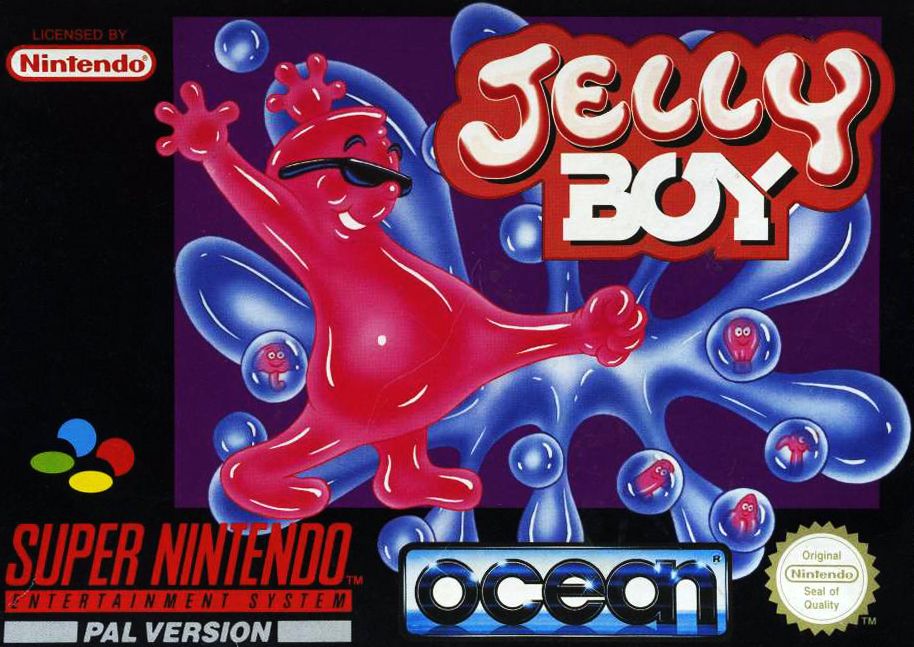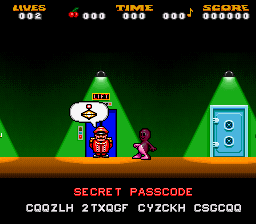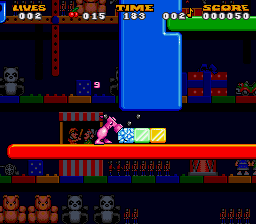Retro Replay Review
Gameplay
Jelly Boy’s gameplay is a delightfully bouncy twist on classic 2D platforming. You control a pink gelatinous blob who can run, jump, and even launch a massive fist from his stomach to clear obstacles or fend off foes. The basic move set feels responsive, and the addition of the stomach-fist attack adds a satisfying layer of depth—especially when timed just right to knock away a tricky enemy or break open a hidden alcove.
(HEY YOU!! We hope you enjoy! We try not to run ads. So basically, this is a very expensive hobby running this site. Please consider joining us for updates, forums, and more. Network w/ us to make some cash or friends while retro gaming, and you can win some free retro games for posting. Okay, carry on 👍)
A key distinguishing feature of the game is its assortment of power-ups, each transforming Jelly Boy into a form with unique capabilities. The hot air balloon lets you float skyward in search of hard-to-reach collectibles; the hammer brings out your inner wrecking ball; the submarine unlocks bonus underwater stages; the skateboard injects speed-run urgency; and the pogo stick grants you sky-high leaps. While most forms feel both fun and functionally useful, the “block” transformation stands out for its comedic frustration—Jelly Boy literally can’t move for a few seconds, reminding players that not every surprise is an advantage.
Rather than a traditional health bar, Jelly Boy uses musical notes as a buffer against damage. Each time you’re hit, your collected notes scatter, and getting hit without notes on hand costs you a life. This system creates a nice risk-reward balance: daring players to push forward with a pocketful of notes, but penalizing slip-ups with the constant threat of starting over. Fruit collection further spices up the equation—beyond earning extra lives, certain fruits confer temporary boons like extra time or brief invincibility.
Levels are varied in theme and challenge—giant toy factories beset by spinning gears, chilling arctic snowfields littered with slippery ice, and more exotic locales that test your mastery of each power-up. The pacing generally feels well-tuned: new hazards and obstacles are introduced steadily, and secret passages often reward careful exploration. Occasional spike pits or fast-moving platforms can feel brutally timed, but save points are judiciously placed to ease frustration.
Graphics
Visually, Jelly Boy is a bright and cheerful spectacle. The titular hero’s pink, semi-transparent sprite bounces and jiggles with an appealing physics-inspired animation that gives him real personality on screen. Backgrounds are richly detailed, from the metallic sheen of assembly-line machinery to the soft blues and whites of frozen tundras. Color palettes are bold without overwhelming the eye, making each stage feel distinct and memorable.
Enemy designs range from simple but cute slimes and robotic drones to more imaginative creations like toy soldiers gone haywire or mischievous snow imps. While most foes animate smoothly, the occasional palette clash or sprite flicker can occur on busier screens. These are minor blemishes in an otherwise polished presentation. Particle effects—confetti from broken blocks, icy sprays from shattering platforms—add flourishes that keep each stage visually engaging.
Character transformations also boast unique animations and color shifts. When Jelly Boy morphs into a hot air balloon, you see ropes stretch and fabric billow; the hammer form exaggerates his size and heft; the submarine form gains a periscope and propeller detail. These touches go beyond mere color swaps, reinforcing the sense that each power-up is an actual new tool rather than a simple palette hack.
While the game doesn’t push pixel counts to their absolute limit, its art direction is cohesive and charming. A playful soundtrack accompanies the visuals, syncing upbeat melodies with on-screen action. Special level themes, like toy factory whistles or wind howls in the arctic, layer in ambient sounds that enrich the mood. Overall, Jelly Boy’s graphics serve the gameplay beautifully and help the world feel alive.
Story
Jelly Boy’s narrative is minimalist—essentially, you guide a gelatinous hero through a series of strange worlds to overcome obstacles and defeat evil forces along the way. There’s no deep lore or lengthy cutscenes, just a concise setup that propels you from one colorful environment to the next. If you’re seeking an epic saga, this isn’t it; the story emphasis is on whimsical action rather than dramatic plot twists.
Despite its simplicity, the game hints at a playful backstory. Why is a pink blob embarking on this perilous journey? The levels themselves serve as narrative beats: the toy factory suggests a mad inventor, the arctic fields imply a sudden climate shift, and bonus areas reveal secret machinery or hidden treasures. In small ways, the level design tells more story than any dialogue box could.
Character interactions are sparse—Jelly Boy rarely meets friendly NPCs or receives explicit missions beyond “make it to the exit.” This keeps the pace brisk but sacrifices opportunities for world-building. That said, the lack of heavy narrative works in the game’s favor by ensuring that each level flows seamlessly into the next without interruption. Players hungry for backstory may find themselves imagining their own motivations for Jelly Boy’s quest.
In the end, the story serves as a playful framing device, just enough to justify the platform puzzles and power-up mechanics. It’s light enough not to distract but present enough to give your gelatinous hero a purpose beyond bouncing aimlessly.
Overall Experience
Jelly Boy delivers a solid slice of 2D platforming nostalgia enriched by creative power-up variety and a unique health-as-musical-notes system. Its strengths lie in tight controls, imaginative level themes, and the joyful feedback of bouncy, gelatinous physics. Whether you’re a genre veteran or a newcomer, the game offers immediate gratification through crisp jumps, inventive boss encounters, and clever stage design.
Difficulty is generally balanced, though some levels spike in challenge—particularly those requiring split-second timing on moving platforms or precise use of a less intuitive power-up. Newcomers may need a few retries to master each environment and its quirks. For completionists, the lure of secret areas and fruit-stacking for extra lives adds replay value beyond the initial run.
One minor drawback is the inconsistent usefulness among power-ups. While most are helpful and fun, the “block” form can feel like a cruel joke during crucial moments. Still, these occasional frustrations are outweighed by the overall joy of discovery—finding that perfect path through a factory conveyor or chaining together bouncing attacks with the pogo stick.
Ultimately, Jelly Boy stands out as a charming, well-crafted platformer that feels fresh without discarding the familiar comforts of the genre. Its colorful visuals, catchy soundtrack, and inventive mechanics make it a worthwhile pick for anyone craving a lighthearted yet challenging adventure. Fans of classic 16-bit platformers should find plenty to love here, and those new to the genre will appreciate the game’s approachable yet rewarding gameplay loop.
 Retro Replay Retro Replay gaming reviews, news, emulation, geek stuff and more!
Retro Replay Retro Replay gaming reviews, news, emulation, geek stuff and more!









Reviews
There are no reviews yet.